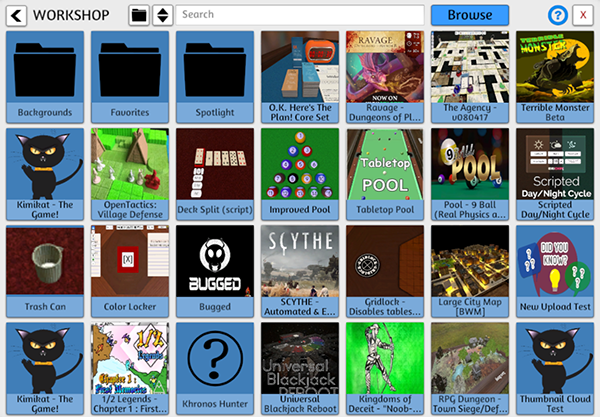
- #HOW TO USE TABLETOP SIMULATOR DUNGEONWORLD SOFTWARE DOWNLOAD#
- #HOW TO USE TABLETOP SIMULATOR DUNGEONWORLD PRO#
- #HOW TO USE TABLETOP SIMULATOR DUNGEONWORLD SOFTWARE#
While Inkarnate is a close second, the one time purchase, huge array of assets, and streamlined UI make this the best solution for larger-scale maps.īuy Wonderdraft for $29.99 at Dungeondraftįrom the same creator as Wonderdraft, Dungeondraft focuses specifically on smaller-scale battlemaps. Wonderdraft is unrivaled in its ability to create regional maps. While battlemaps can be created using the software, it is certainly not meant for this application.
#HOW TO USE TABLETOP SIMULATOR DUNGEONWORLD SOFTWARE#
#HOW TO USE TABLETOP SIMULATOR DUNGEONWORLD PRO#
The layering, blending, and usage of assets has a similar feel to the infamous image editing software and while it might not be the most streamlined D&D map-making software, it is a great mix of easy to use and customizable.Ĭheck out the free or pro version at Wonderdraft I do have to say that creating a map with lots of rooms, such as a dungeon or large building, is a bit of a grind with Inkarnate simply due to the level of detail they require.Īll in all, I would compare Inkarnate to a “map-focused Photoshop”. Inkarnate’s regional map maker is also a great tool, though I tend to use it much less often. Because I try to keep my session prep to under two hours, it’s extremely nice to be able to punch out a detailed map in five to ten minutes. I have found myself reaching for Inkarnate most of the time I am creating a straightforward battlemap. Inkarnate can be used to create regional maps and battlemaps. UI can get slow on big maps with lots of assets or slow internet connection.Subscription model, not a one time purchase.Walls don’t “snap” together, which can make the creation of dungeons or other indoors areas clunky.Pro version allows for commercial sale of maps.UI is thorough enough to create amazing maps but streamlined enough to build maps quickly.
#HOW TO USE TABLETOP SIMULATOR DUNGEONWORLD SOFTWARE DOWNLOAD#

They show the region from a bird’s-eye view. These maps are typically on a larger scale than battlemaps. There are two main types of maps used commonly in D&D: regional maps and battlemaps. Whether you play in-person or online and with or without battlemaps, chances are you will be creating a map for something while playing D&D. Some groups may rely on the DM’s descriptions of the locations they find themselves in, while other groups use maps. Because it is a tabletop game, most of the visualization in D&D is left up to the imagination.


 0 kommentar(er)
0 kommentar(er)
